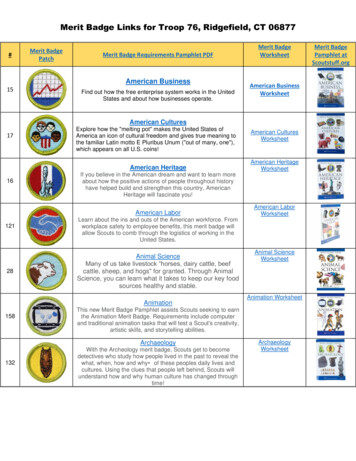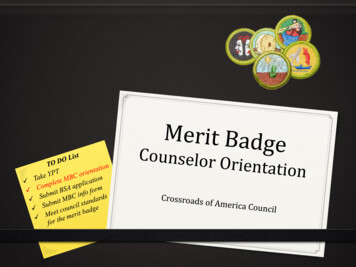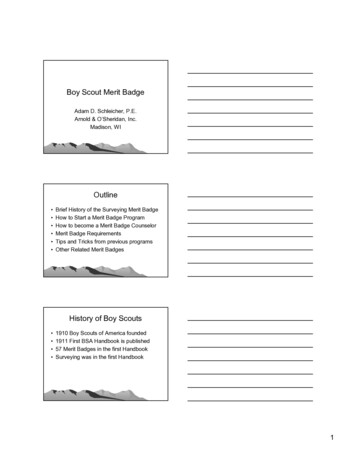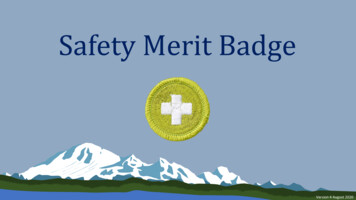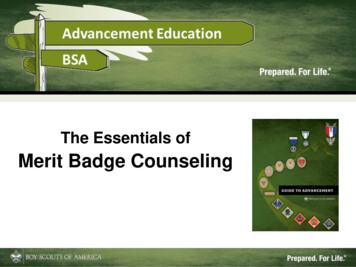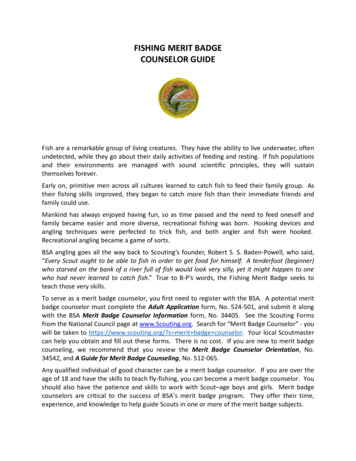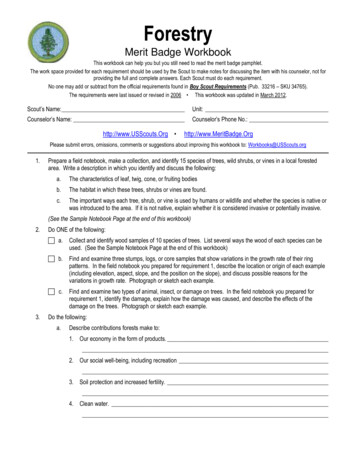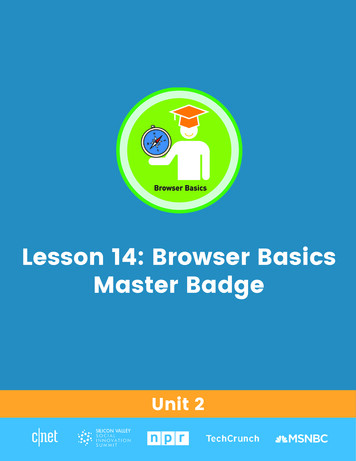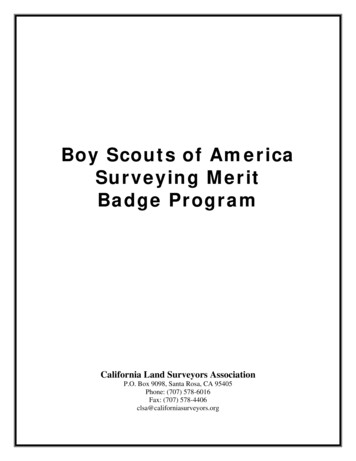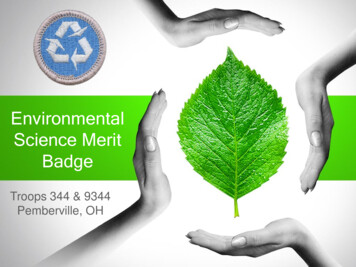
Transcription
EnvironmentalScience MeritBadgeTroops 344 & 9344Pemberville, OH
Environmental Science Merit Badge Requirements1.2.Make a timeline of the history of environmental science inAmerica. Identify the contribution made by the Boy Scouts ofAmerica to environmental science. Include dates, names ofpeople or organizations, and important events.Define the following terms: population, community, ecosystem,biosphere, symbiosis, niche, habitat, conservation, threatenedspecies, endangered species, extinction, pollution prevention,brownfield, ozone, watershed, airshed, nonpoint source, hybridvehicle, fuel cell.
Environmental Science Merit Badge Requirements3. Do ONE activity from seven of the following categories (using theactivities in the merit badge pamphlet as the basis for planning andcarrying out your projects):a. Ecology1. Conduct an experiment to find out how living things respondto changes in their environments. Discuss your observationswith your counselor.2. Conduct an experiment illustrating the greenhouse effect.Keep a journal of your data and observations. Discuss yourconclusions with your counselor.3. Discuss what is an ecosystem. Tell how it is maintained innature and how it survives.
Environmental Science Merit Badge Requirements3. Do ONE activity from seven of the following categories (using theactivities in the merit badge pamphlet as the basis for planning andcarrying out your projects):b. Air Pollution1. Perform an experiment to test for particulates that contributeto air pollution. Discuss your findings with your counselor.2. Record the trips taken, mileage, and fuel consumption of afamily car for seven days, and calculate how many miles pergallon the car gets. Determine whether any trips could havebeen combined (chained) rather than taken out and back.Using the idea of trip chaining, determine how many milesand gallons of gas could have been saved in those sevendays.3. Explain what is acid rain. In your explanation, tell how itaffects plants and the environment and the steps society cantake to help reduce its effects.
Environmental Science Merit Badge Requirements3. Do ONE activity from seven of the following categories (using theactivities in the merit badge pamphlet as the basis for planning andcarrying out your projects):c. Water Pollution1. Conduct an experiment to show how living things react tothermal pollution. Discuss your observations with yourcounselor.2. Conduct an experiment to identify the methods that could beused to mediate (reduce) the effects of an oil spill onwaterfowl. Discuss your results with your counselor.3. Describe the impact of a waterborne pollutant on an aquaticcommunity. Write a 100-word report on how that pollutantaffected aquatic life, what the effect was, and whether theeffect is linked to biomagnification.
Environmental Science Merit Badge Requirements3. Do ONE activity from seven of the following categories (using theactivities in the merit badge pamphlet as the basis for planning andcarrying out your projects):d. Land Pollution1. Conduct an experiment to illustrate soil erosion by water.Take photographs or make a drawing of the soil before andafter your experiment, and make a poster showing yourresults. Present your poster to your patrol or troop.2. Perform an experiment to determine the effect of an oil spillon land. Discuss your conclusions with your counselor.3. Photograph an area affected by erosion. Share yourphotographs with your counselor and discuss why the areahas eroded and what might be done to help alleviate theerosion.
Environmental Science Merit Badge Requirements3. Do ONE activity from seven of the following categories (using theactivities in the merit badge pamphlet as the basis for planning andcarrying out your projects):e. Endangered Species1. Do research on one endangered species found in your state. Findout what its natural habitat is, why it is endangered, what is beingdone to preserve it, and how many individual organisms are left inthe wild. Prepare a 100-word report about the organism, includinga drawing. Present your report to your patrol or troop.2. Do research on one species that was endangered or threatenedbut which has now recovered. Find out how the organismrecovered, and what its new status is. Write a 100-word report onthe species and discuss it with your counselor.3. With your parent's and counselor's approval, work with a naturalresource professional to identify two projects that have beenapproved to improve the habitat for a threatened or endangeredspecies in your area. Visit the site of one of these projects andreport on what you saw.
Environmental Science Merit Badge Requirements3. Do ONE activity from seven of the following categories (using theactivities in the merit badge pamphlet as the basis for planning andcarrying out your projects):f.Pollution Prevention, Resource Recovery, andConservation1. Look around your home and determine 10 ways your familycan help reduce pollution. Practice at least two of thesemethods for seven days and discuss with your counselorwhat you have learned.2. Determine 10 ways to conserve resources or use resourcesmore efficiently in your home, at school, or at camp. Practiceat least two of these methods for seven days and discusswith your counselor what you have learned.3. Perform an experiment on packaging materials to find outwhich ones are biodegradable. Discuss your conclusionswith your counselor.
Environmental Science Merit Badge Requirements3. Do ONE activity from seven of the following categories (using theactivities in the merit badge pamphlet as the basis for planning andcarrying out your projects):g. Pollination1. Using photographs or illustrations, point out the differencesbetween a drone and a worker bee. Discuss the stages of beedevelopment (eggs, larvae, pupae). Explain the pollinationprocess, and what propolis is and how it is used by honey bees.Tell how bees make honey and beeswax, and how both areharvested. Explain the part played in the life of the hive by thequeen, the drones, and the workers.2. Present to your counselor a one-page report on how and whyhoney bees are used in pollinating food crops. In your report,discuss the problems faced by the bee population today, andthe impact to humanity if there were no pollinators. Share yourreport with your troop or patrol, your class at school, or anothergroup approved by your counselor.3. Discuss with your counselor the effectiveness of native bees aspollinators. Identify some of the native bees found in your area.Construct and install a native bee house.
Environmental Science Merit Badge Requirements3. Do ONE activity from seven of the following categories (using theactivities in the merit badge pamphlet as the basis for planning andcarrying out your projects):h.Invasive Species1. Learn to identify the major invasive plant species in yourcommunity or camp and explain to your counselor what can bedone to either eradicate or control their spread.2. Do research on two invasive plant or animal species in yourcommunity or camp. Find out where the species originated, howthey were transported to the United States, their life history, howthey are spread, and the recommended means to eradicate orcontrol their spread. Report your research orally or in writing toyour counselor.3. Take part in a project of at least one hour to eradicate or controlthe spread of an invasive plant species in your community orcamp.
Environmental Science Merit Badge Requirements4.Choose two outdoor study areas that are very different from oneanother (e.g., hilltop vs. bottom of a hill; field vs. forest; swampvs. dry land). For BOTH study areas, do ONE of the following:a. Mark off a plot of four square yards in each study area, andcount the number of species found there. Estimate how muchspace is occupied by each plant species and the type andnumber of nonplant species you find. Report to your counselororally or in writing the biodiversity and population density ofthese study areas. Discuss your report with your counselor.b. Make at least three visits to each of the two study areas (for atotal of six visits), staying for at least 20 minutes each time, toobserve the living and nonliving parts of the ecosystem. Spaceeach visit far enough apart that there are readily apparentdifferences in the observations. Keep a journal that includes thedifferences you observe. Discuss your observations with yourcounselor.
Environmental Science Merit Badge Requirements5.6.Using the construction project provided or a plan you create onyour own, identify the items that would need to be included in anenvironmental impact statement for the project planned.Find out about three career opportunities in environmentalscience. Pick one and find out the education, training, andexperience required for this profession. Discuss this with yourcounselor, and explain why this profession might interest you.
Requirement 1: Timeline1.Make a timeline of the history of environmental science inAmerica: Identify the contribution made by the Boy Scouts ofAmerica to environmental science. Include dates, names ofpeople or organizations, and important events.
Requirement 1: TimelineNative Americans Native Americans often manipulatedtheir local environments and profoundlyshaped the ecosystems around them.– It was common for some tribes to clearland for farming by cutting and burningforests.– The burning of forest to improve huntingestablished the Oak Openings region innorthwest Ohio and southeast Michigan.Once cleared, fields were farmed extensivelyuntil soil fertility was depleted; then theycleared new lands and started the processagain.Similarly, where game was plentiful,Indians used only the choicest cuts andleft the rest.
Requirement 1: TimelineYellowstone National Park Established by the U.S. Congressand signed into law by PresidentUlysses S. Grant on March 1, 1872.Yellowstone was the first nationalpark in the U.S. and is also widelyheld to be the first national park in theworld.
Requirement 1: TimelineSierra Club The Sierra Club is an environmental organizationin the United States.It was founded on May 28, 1892, in San Francisco,California, by the Scottish-Americanpreservationist John Muir.
Requirement 1: TimelineGifford Pinchot The scale of environmental devastation in the UnitedStates traces its origins to early colonialism.Colonialists saw “new” territories as places withseemingly inexhaustible natural resources to exploit,with little consideration for the long-term impacts.The idea of conservation only began to gain popularityin the United States at the end of the 1800s.Gifford Pinchot founded the conservation movement inthe United States in the late 1890s.Pinchot's ideas were inspired by his observations ofenvironmental destruction and unregulated wildernessexploitation during the 1800s.Pinchot had great influence during the presidency ofTheodore Roosevelt and he helped to steerconservation policies from the turn of the century untilthe 1940s.
Requirement 1: TimelinePresident Theodore Roosevelt 1901-1909 The conservation legacy ofTheodore Roosevelt isfound in the 230 millionacres of public lands hehelped establish during hispresidency.Roosevelt created thepresent-day USFS in 1905to conserve forests forcontinued use.Roosevelt wanted to insurethe sustainability of thoseresources.Roosevelt and John Muir inYosemite Valley
Requirement 1: TimelineUS Forest Service Congress created the US Forest Service in 1905.The Forest Service manages 193 million acres (780,000 km2) of land.Forest Service’s mission is to sustain the health, diversity, and productivityof the Nation's forests and grasslands to meet the needs of present andfuture generations.
Requirement 1: TimelineDust Bowl The Dust Bowl was a period of severe dust storms that greatlydamaged the ecology and agriculture of the American and Canadianprairies during the 1930s; severe drought and a failure to apply drylandfarming methods to prevent wind erosion caused the phenomenon.
Requirement 1: TimelineSilent Spring Silent Spring is anenvironmental science bookby Rachel Carson. The bookwas published on September27, 1962, documenting theadverse environmentaleffects caused by theindiscriminate use ofpesticides, particularly DDT.
Requirement 1: TimelineCuyahoga River Fire 1969 Fires were nothing out of the ordinaryon Cleveland’s Cuyahoga River in the1960s.The river, which empties into Lake Erie,had long been a dumping place forsewage and industrial waste.On June 22, 1969, a spark from traintracks ignited industrial debris floatingon the surface of the water.Flames spread across the river, insome places reaching five stories high.The river fire helped create anenvironmental revolution thatculminated in the creation of theEnvironmental Protection Agency.
Requirement 1: TimelineNational Environmental Policy Act 1969 National Environmental PolicyAct (NEPA), the first major U.S.environmental law.Enacted in 1969 and signed intolaw in 1970 by President RichardM. Nixon.NEPA requires all federalagencies to go through a formalprocess before taking any actionanticipated to have substantialimpact on the environment.
Requirement 1: TimelineClean Air Act 1970 The Clean Air Act is a United Statesfederal law designed to control airpollution on a national level.It is one of the United States' firstand most influential modernenvironmental laws, and one of themost comprehensive air quality lawsin the world.Los Angeles 1970Los Angeles 2020
Requirement 1: TimelineEPA Established 1970 Born in the wake of elevated concernabout environmental pollution.EPA was established on December2, 1970 to consolidate in one agencya variety of federal research,monitoring, standard-setting andenforcement activities to ensureenvironmental protection.
Requirement 1: TimelineEarth Day 1970 Earth Day was founded in 1970as a day of education aboutenvironmental issues.The holiday is now a globalcelebration that's sometimesextended into Earth Week, a fullseven days of events focused ongreen living.
Requirement 1: TimelineClean Water Act 1972Then NowThe Clean Water Act is a U.S. federal law that regulates the discharge ofpollutants into the nation's surface waters, including lakes, rivers, streams,wetlands, and coastal areas.Passed in 1972 and amended in 1977 and 1987, the Clean Water Act wasoriginally known as the Federal Water Pollution Control Act.
Requirement 1: TimelineLove Canal Love Canal is a neighborhood inNiagara Falls, New York, infamous asthe location of a 70-acre landfill thatbecame the site of a massiveenvironmental disaster in the 1970s.During the 1940s the Hooker ChemicalCompany used the site to dump tons ofchemical byproducts and eventuallysold it to the local school district in1953.It attracted national attention for thepublic health problem originating fromthe former dumping of toxic waste onthe site that resulted in families withlongstanding health issues andsymptoms of leukemia.
Requirement 1: TimelineLove Canal The federal government passed the Superfund law in 1980 which was designedto investigate and clean up sites contaminated with hazardous substances.The resulting Superfund cleanup operation demolished the neighborhood,ending during 2004.
Requirement 1: TimelineExxon Valdez 1989 The Exxon Valdez oil spill was a manmadedisaster that occurred when Exxon Valdez, anoil tanker owned by the Exxon ShippingCompany, spilled 11 million gallons of crudeoil into Alaska's Prince William Sound onMarch 24, 1989.It was the worst oil spill in U.S. history until theDeepwater Horizon oil spill in 2010.
Requirement 1: Timeline The Deepwater Horizon oil spillis an industrial disaster thatbegan on April 20, 2010, in theGulf of Mexico on the BPoperated Macondo Prospectand is considered to be thelargest marine oil spill in thehistory of the petroleumindustry.
Requirement 1: BSA Contribution to EnvironmentalScience 1902 – The Woodcraft Indians was started in Connecticut bythe naturalist Ernes Thompson Seton to preserve thewilderness knowledge of American Indians.1904 – William T. Hornaday authored legislation to protectmigratory birds.1905 – Daniel Carter Beard founded club called the Sons ofDaniel Boone to teach boys about nature, conservation, andoutdoorsmanship.1910 – Seton and Beard merged their boys’ clubs into the BoyScouts of America. William D. Boyce founded this neworganization.Many of the principles that Scouts uphold come from theconservation ethics of Seton and Beard.As of 2020, BSA has taught more than 110 million participantsenvironmental principles.As of 2020, with more than 3.3 million participants, BSAcontinues to teach principles of conservation andenvironmental science.
Requirement 1: BSA Contribution to EnvironmentalScienceOutdoor CodeAs an American, I will do mybest to Be clean in my outdoormanners. Be careful with fire. Be considerate in theoutdoors. Be conservation minded.
Requirement 1: BSA Contribution to EnvironmentalScienceThe Principles of Leave No Trace1.2.3.4.5.6.7.Plan ahead and prepare.Travel and camp on durable surfaces.Dispose of waste properly (pack it in,pack it out).Leave what you find.Minimize campfire impacts.Respect wildlife.Be considerate of other visitors.
Requirement 2: Defining Terms2. Define the following terms: population,community, ecosystem, biosphere, symbiosis,niche, habitat, conservation, threatened species,endangered species, extinction, pollutionprevention, brownfield, ozone, watershed,airshed, nonpoint source, hybrid vehicle, fuelcell.
Requirement 2: Defining TermsEnvironmental Science Terms Population -a group of thesame organism in an area.Community -manypopulations living andinteracting together.Ecosystem -the interactionbetween all living and nonliving things in an area.
Requirement 2: Defining TermsBiosphere Our living world where alltrees, bugs, and animals live.The biosphere extends to anyplace that life (of any kind)can exist on Earth.
Requirement 2: Defining TermsSymbiosis A close and often longterm interaction betweentwo or more differentbiological species.
Requirement 2: Defining TermsNiche Defines an organism's role in an ecosystem. A niche may alsoencompass what the organism eats, how it interacts with other living(biotic) elements, and also how it interacts with the nonliving (abiotic)aspects of the environment, as well.
Requirement 2: Defining TermsHabitat The natural home orenvironment of an animal,plant, or other organism.
Requirement 2: Defining TermsConservation Practices that protect animals,plants and the environment.
Requirement 2: Defining TermsThreatened vs Endangered Threatened Species– Any species which are“likely” to become anendangered specieswithin the foreseeablefuture. Endangered Species– A species in danger of“extinction” throughout allor a significant portion ofits range.
Requirement 2: Defining Terms
Requirement 2: Defining Terms
Requirement 2: Defining TermsExtinction is the termination of a species.
Requirement 2: Defining TermsPollution Prevention Activities that reduce theamount of pollutiongenerated by a process,whether it is consumerconsumption, driving, orindustrial production
Requirement 2: Defining TermsBrownfield Brownfield sites areabandoned or underusedindustrial and commercialfacilities available forexpansion, redevelopment,or reuse which may becomplicated by thepresence or potentialpresence of a hazardoussubstance, pollutant, orcontaminant.
Requirement 2: Defining TermsOzone Atmospheric Ozone is producedwhen ultraviolet radiationinteracts in the stratosphere.Ozone in the atmosphere isnaturally produced anddestroyed at a constant rate.Ozone protects the earth fromharmful UV radiation whichdamages skin, eyes, and theimmune system of life forms.Ozone makes life on earthpossible.Ground-level Ozone is a majorpollutant and green house gas.
Requirement 2: Defining TermsWatershed A watershed is the area ofland where all of the waterthat is under it or drains offof it goes into the sameplace.
Requirement 2: Defining TermsAirshed An airshed can becompared to a watershed.an airshed is a geographicarea where air pollutantsfrom sources "upstream"or within the area flow andare present in the air.
Requirement 2: Defining TermsNonpoint source pollution Nonpoint source (NPS) is a source of pollution,discharged over a wideland area, not from onespecific location such as apipe discharge.Example: rainwater runoff
Requirement 2: Defining TermsHybrid vehicle A vehicle that usestwo or more distinctpower sources tomove the vehicle.
Requirement 2: Defining TermsFuel cell A device that convertsthe chemical energyfrom a fuel intoelectricity through achemical reaction withoxygen or anotheroxidizing agent.
Requirement 3a3. Do ONE activity from seven of the following categories(using the activities in the merit badge pamphlet as thebasis for planning and carrying out your projects):a. Ecology1. Conduct an experiment to find out how living things respondto changes in their environments. Discuss your observationswith your counselor.2. Conduct an experiment illustrating the greenhouse effect.Keep a journal of your data and observations. Discuss yourconclusions with your counselor.3. Discuss what is an ecosystem. Tell how it is maintained innature and how it survives.
Requirement 3a1Conduct an experiment to find out how living things respond tochanges in their environments. Discuss your observations with yourcounselor.How Does the Environment Affect Living Things?You have learned that the nonliving parts of the environment haveimportant effects on living things. In this experiment you will learnhow light affects earthworms.ProcedureStep 1 – Cut the shoe box lid in half. Put half of the lid on the shoebox so that it shades one side of the box.Step 2 – Place a lamp next to the middle of the shoebox, closeenough that it shines on the uncovered part of the box.Step 3 – Place 10 earthworms on the centerline of the bottom ofthe box so that the worms are half in the dark and half in the light.Step 4 – Observe the worms for five minutes. Note their behaviorin a notebook.Step 5 – When your experiment is over, take the worms outsideand return them to the soil.
Requirement 3a1Conduct an experiment to find out how living things respond tochanges in their environments. Record your observations andconclusions in a notebook and discuss with your counselor.Observations1. What did the worms do at the beginning of the experiment?2. How much time did the worms spend in the lighted part of the box? In the shaded part ofthe box?3. What nonliving environment factor does the lamp represent?ConclusionsAn organism’s response to light is called phototropism. Anorganism that responds to light by moving toward it is saidto be positively phototropic. An organism that moves awayfrom light is negatively phototropic. Which type of responsedid your worms show? Why would earthworms react thisway to light?
Requirement 3a2Conduct an experiment illustrating the greenhouse effect. Keep ajournal of your data and observations. Discuss your conclusions withyour counselor.The Greenhouse EffectThis activity demonstrates how the atmosphere traps thesun’s energy to warm the Earth’s surface.ProcedureStep 1 – Using scissors, cut the tops off of two clear 2-litersoda bottles. Make your cut about 4 inches from the top. Labelon bottle “A” and the other bottle “B”.Step 2 – Pour 2 cups of garden soil or potting soil into eachbottle.Step 3 – Place a thermometer inside each bottle. Make surethe thermometers are placed at the same distance above thesoil in each bottle.Step 4 – Cover the top of bottle B with clear plastic wrap andsecure it with a rubber band or tape.
Requirement 3a2Conduct an experiment illustrating the greenhouse effect. Keep ajournal of your data and observations. Discuss your conclusions withyour counselor.The Greenhouse Effect (continued)ProcedureStep 5 – Place a lamp on a table, removing the lampshade toexpose the lightbulb. Position each bottle exactly 1 inch fromthe exposed bulb. Be sure to turn the bottles so that thethermometers face away from the lightbulb. You may need toshade the thermometers from direct light to get accuratereadings of air temperatures.Step 6 – With the light off, record the temperature in each bottlein your notebook.Step 7 – Turn on the lamp.Step 8 – Using a watch, wait three minutes, and then record thetemperatures again. Record the temperatures in each bottleevery three minutes for 15 minutes.
Requirement 3a2Conduct an experiment illustrating the greenhouse effect. Keep ajournal of your data, observations, and conclusions. Discuss yourconclusions with your counselor.Observations1. Did the temperature in each bottle change during yourexperiment?2. Explain what the lightbulb and the plastic wrap represent inthis model of the greenhouse effect.ConclusionsCompare your experimental setup to realconditions on Earth. Using your data, explainwhy the greenhouse effect makes it possiblefor life to exist on Earth.
Requirement 3a3Discuss what is an ecosystem. Tell how it is maintainedin nature and how it survives. An ecosystem is a community ofliving organisms in conjunctionwith the nonliving components oftheir environment, interacting as asystem. These biotic and abioticcomponents are linked togetherthrough nutrient cycles andenergy flows.
Requirement 3a3CARBON CYCLE
Requirement 3a3WATER CYCLEPHOSPHORUS CYCLE
Requirement 3a3
Requirement 3b3.Do ONE activity from seven of the following categories (using theactivities in the merit badge pamphlet as the basis for planningand carrying out your projects):b. Air Pollution1.2.3.Perform an experiment to test for particulates that contribute toair pollution. Discuss your findings with your counselor.Record the trips taken, mileage, and fuel consumption of a familycar for seven days, and calculate how many miles per gallon thecar gets. Determine whether any trips could have been combined('chained') rather than taken out and back. Using the idea of tripchaining, determine how many miles and gallons of gas couldhave been saved in those seven days.Explain what is acid rain. In your explanation, tell how it affectsplants and the environment and the steps society can take tohelp reduce its effects.
Requirement 3b1Perform an experiment to test for particulates that contribute to airpollution. Discuss your findings with your counselor.Air PollutionIn this experiment, you will observe some of theparticulates that pollute air.ProcedureStep 1 – Spread a thin film of petroleum jelly ontwo paper plates or two 3 by 5 inch index cards.These will serve as your air pollution collectors.Step 2 – Place one collector in an urbanenvironment, such as near a busy street. Placethe other collector in a nonurban environment,such as in a field or a forested area.Step 3 – Protect each collector from precipitationby placing a cover above it or placing itunderneath an overhanging roof or tree limb.Step 4 – Leave both collectors in place for oneweek.
Requirement 3b1Perform an experiment to test for particulates that contribute to airpollution. Discuss your findings with your counselor.Air Pollution (continued)ProcedureStep 5 – Retrieve the collectors. Using a magnifying glass, look at the surface of eachcollector to identify any particulates.Step 6 – Place a sheet of clear plastic, marked off in a grid of 1 inch squares, over onecollector. Using the magnifying glass, count the number of particulates in four of thesquares. Find the average number of particulates in a square and record this number.Step 7 – Repeat step 6 for the other collector.
Requirement 3b1Perform an experiment to test for particulates that contribute to airpollution. Discuss your findings with your counselor.Observations1. What was the average number of particulates on the collector left in an urbanenvironment? In the nonurban environment?2. What do the particulates on the two collectors suggest about the level of particulatepollution in each environment?ConclusionsUsing your data, report what you learned about how particulates contribute to airpollution in urban and rural environments.
Requirement 3b2Trip dayTrip 1 LocationTrip 2 LocationTrip 3 LocationTrip 4 LocationTrip 5 LocationTotal MileageFuel usedMPGDetermine whether any trips could have been combined ('chained') rather thantaken out and back. Using the idea of trip chaining, determine how many miles andgallons of gas could have been saved in those seven days.
Requirement 3b3What is acid rain? Acidity is a propertymeasured on a scale calledthe pH scale with a rangeof 0 to 14. Pure water has a pH of 7. Rain is naturally slightlyacidic, with a pH of about5.6, this is because carbondioxide in the atmospherereacts with water vapor tobecome carbonic acid.
Requirement 3b3What is acid rain? Sulfur dioxide andnitrogen oxides arethe primary causesof acid rain.When vehicles andpower plants thatburn fossil fuelsemit sulfur dioxideand nitrogen oxidesinto the air, thesegases interact withwater vapor to formsulfuric and nitricacids.These acids thenmix with rain andfall to Earth’ssurface as acid rain.Acid rain can deplete the soil of the nutrients thatplants need to grow. When acid rain falls, it filtersdown through the soil and dissolves soil nutrients andother materials, moving them down to layers out ofreach of plant roots.
Requirement 3b3How acid rain effects the environment.Plants and Trees Reduces crop production, damage to seeds.Reduces quality of crops.Plants may die from acid rain or be weakened so that they are moreeasily harmed by other kinds of stresses in the environment, such ascold temperatures, insect damage, or droughts.Aquatic Ecosystems Acid rain damages aquatic ecosystems by changing the
environmental impact statement for the project planned. 6. Find out about three career opportunities in environmental science. Pick one and find out the education, training, and experience required for this profession. Discuss this with your counselor, and explain why this profession might interest you. Environmental Science Merit Badge .
